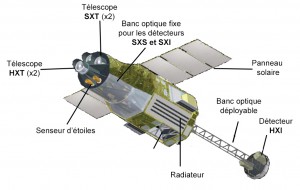So just after I made the last post about a potential save of the Hitomi X-ray telescope, news comes that the satellite is gone for good this time. Due to a software error, the telescope was sent spinning out of control until it basically tore itself apart. Sadly, this 10-year planned mission ended up giving only a few days of data collection.
At 3:01 a.m. Japan time on March 26, the spacecraft began a preprogrammed manoeuvre to swivel from looking at the Crab Nebula to the galaxy Markarian 205. Somewhere along the way, the problems with the star tracker caused Hitomi to rely instead on another method, a set of gyroscopes, to calculate its orientation in space. But those gyroscopes were reporting, erroneously, that the spacecraft was rotating at a rate of about 20 degrees each hour. Tiny motors known as reaction wheels began to turn to counteract the supposed rotation.

